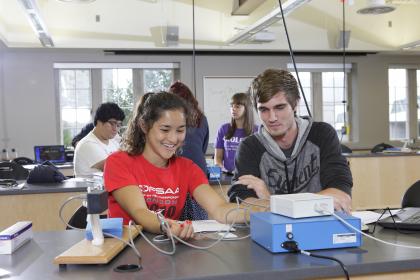Looking through walls and into cells
Thursday, October 25, 2012

Glass walls, an open concept, and modern furnishings have created a bright, interactive atmosphere for learning in the newly-renovated Physiology and Pharmacology laboratories. Opened September 25, the labs encompass 7,000 sq ft of teaching space, and features an additional 2,000 sq ft of research space for students on the second floor of the Dental Sciences Building.
The previous labs had been built in the 1960's and an external review of the Department included the statement, "the floor plan, the walls, the cupboards and general appearance of the labs gave me the impression that I was stepping into a museum display."
That certainly isn't the case anymore. The new labs include multi-function flexibility provided by movable benches and walls, integrated meeting rooms, wet and dry labs, offices, prep rooms and tissue culture facilities to accommodate current and future undergraduate and graduate courses. Students and faculty members will also find a state-of-the-art IT network and A/V presentation capabilities at their fingertips.
Graduate student Jennifer Hughes-Large commented, "It's great to finally have a big, comfortable, up-to-date lab area in which to teach students. We are also very privileged to have been able to move into the adjacent lab space. The open concept design is great for trainee interaction, there is ample storage space, separate cell culture rooms for each lab, and we finally have room for roller-chair lab races!" The teaching space is designed to accommodate up to 100 students in each of the "wet" and "dry" labs where students will study physiology, pharmacology and anatomy, the basis for disease mechanisms and therapeutic targets, and translational research. Students will be able to engage in and learn from hands-on experiments of how the body functions at the molecular, cellular, animal model and human levels.
Also housed in the new space will be two faculty members, Dr. Nica Borradaile and Dr. Brad Urquhart, along with their research trainees and staff. With research focused on obesity, type 2 diabetes, and kidney failure, these two researchers are poised to make the best of their new cutting edge facilities.








